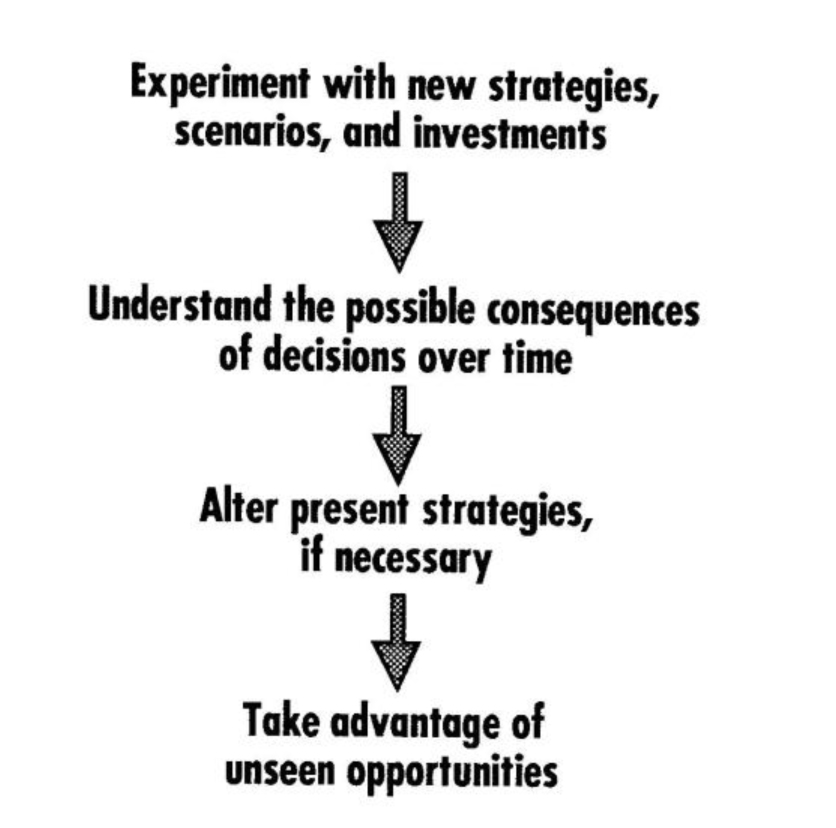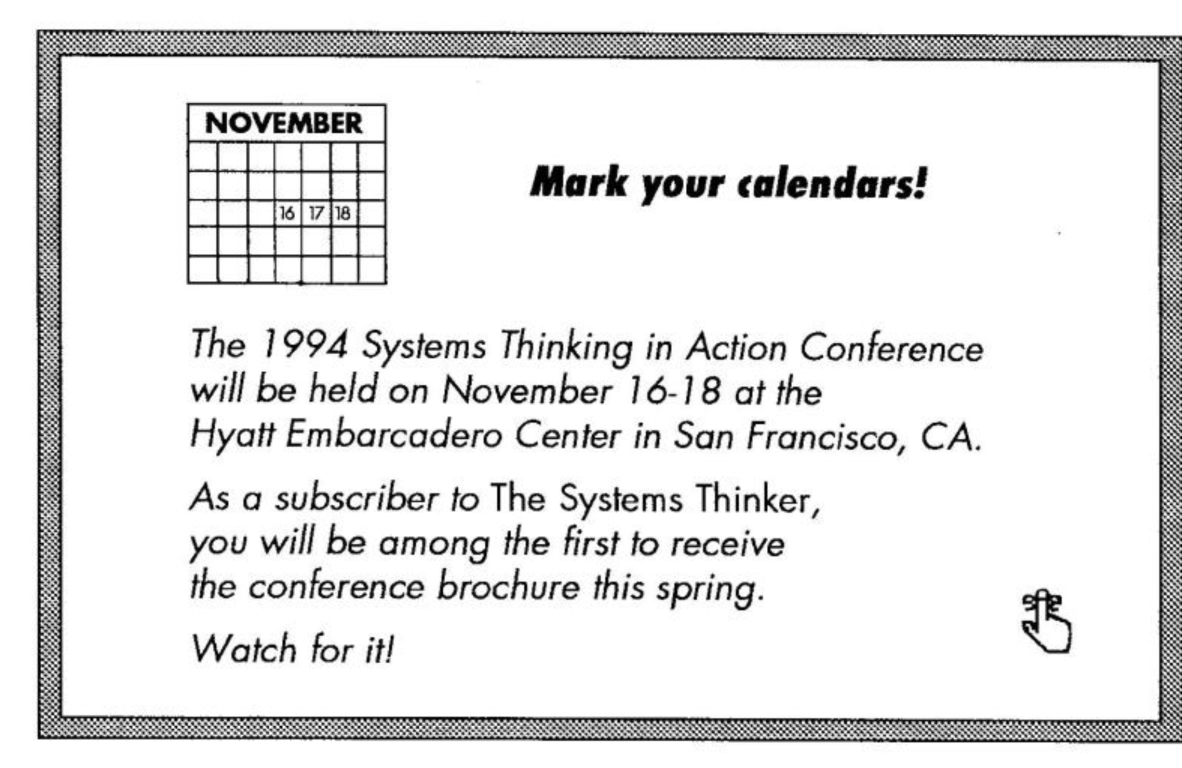Your customers are demanding more services for the same price. How can you meet their expectations with your existing staff?
As your company begins to gain market share, new competitors enter your markets with lower prices and more production capacity. What should you do?
Producing the next generation of your product will take heavy spending in R&D, but additional marketing might boost sales now. Where should you make the investment?
Strategy experiments help managers understand cause-and-effect relationships that often lead to surprising, non-intuitive results — including the discovery of unseen opportunities.
Strategy Experiments
Strategy experiments can provide clues that help managers make more informed, systemically-aware decisions. By experimenting with new strategies, scenarios, and investments, managers can better understand the possible consequences of their decisions before they have committed themselves to a particular path.
Simulations can also give a better understanding of consequences of decisions over time, indicating when it is necessary to change strategies as a market matures or undergoes transition.
Strategy experiments help managers understand cause-and-effect relationships that often lead to surprising, non-intuitive results — including the discovery of unseen opportunities. For example, teams of managers can use simulations to make critical investment decisions. A company considering price reductions might expect increased product demand and responses from competitors. A carefully-constructed simulation can help them understand which circumstances might lead to increased market share and which might result in a price war.
Using Simulation in Scenario Planning
Simulations can be especially effective when used as scenario planning tools. This differs from their traditional use in fore-casting. Instead of providing an estimate of next year’s sales in a particular market, strategy simulations are used to understand the likely consequences of a change in advertising on sales, or a competitor’s response to the introduction of an unforeseen product improvement.
Using Strategy Simulation

Effective strategy experimentation requires that managers stay focused on their business needs and the purpose of the strategic planning process. There are at least four major recommendations for strategy simulation developers:
- Solve a particular problem, or focus on one issue. Do not try to analyze the entire business.
- Before beginning, understand how the results might be used after the strategy experiment is finished.
- Make the simulation as simple as possible. Add complexity only as necessary to make the simulation realistic.
- Keep all decision makers involved in the model building process.
Focus on One Issue
Start by focusing the model development effort on solving a particular problem. Ask what the team wants to know and what the simulation should help them understand. This may sound trivial, but many simulation efforts start with no clear problem or issue to consider. In these unfortunate cases, managers begin modeling their company with the vague goal of trying to better understand their business. If the simulation is too general, nobody will know what to do with the strategy simulation once it is finished.
The process of creating a simulation is as important as using the simulation… jointly creating a model forces managers to be explicit about their views on corporate activities, strategies, and outcomes.
Build the Strategy Experiment for How It Will Be Used
If a simulation is going to be used for strategic planning, then the simulation results must appear in a format that is easy to see and familiar to the managers that will be using it. For example, if the managers are used to analyzing results on balance sheets and income statements, then representations of pro forma balance sheets and income statements should appear in the simulation.
Another important consideration is the ability to view the simulation results. When a simulation is used during a strategy meeting, sometimes the most experienced, senior managers are furthest away from the computer. If not everyone can analyze the results, there is a tendency for the person sitting closest to the computer to become the “expert,” interpreting the results for the rest of the group. This can be frustrating for other meeting participants.
Keep the Strategy Simulation as Simple as Possible
Probably the most important suggestion for building models to use in strategic planning is to stay simple. As in many other activities, there is a tendency in strategy simulation toward increased complexity. However, it is best to start with absolutely the simplest solution possible. For example, if you are considering purchasing new capital equipment, begin a simulation with one simple link from desired capacity to current sales and nothing else. After this simple model is working, add inventory, available labor, investment constraints, etc. Add complexity only as necessary. If you are focusing on a particular problem, you should first have a definition of what you want to better understand and how the model will be used. These definitions will help put constraints on what will be included in the model.
Keep Everyone Involved
Ideally, managers should be responsible for defining and creating the simulation. At the very least, managers should provide all of the background information. Many analysts who use simulation tools think of themselves as experts providing specific advice to their colleagues or clients. While this method works well for some forms of analysis or consulting, it is inappropriate when creating strategy simulations.
The process of creating a simulation is often as important as using the simulation. Jointly building a model with experienced managers can help those managers better understand and define their problem. The process of jointly creating a model forces managers to be explicit about their views on corporate activities, strategies, and outcomes.
With full participation from the simulation users, the finished model will be able to simulate the impact of decisions based on participants’ different perspectives. In some cases, these differences of opinion will have little impact on the results. Thus, the modeling work is able to help people resolve differences of opinion and accurately depict the understanding and insights of an entire group.
The other important advantage of involving simulation users in the model-building process is higher confidence in the model results. If the simulation produces a non-intuitive result, managers who were involved in the model-building process will be more likely to try to determine its causes rather than dismiss the model as inaccurate.
Strategy simulation can be a useful supplement to the strategic planning process. If done well, these simulations can be used continually by managers who want to test assumptions about their business. When strategy simulation is combined with scenario planning, managers can use simulations in new ways. Teams can get together to discuss new strategies and use the computer simulation as an aid to that discussion. Instead of emphasizing the analytical aspects of a problem, the simulation can emphasize discussion and understanding.
Michael Bean, president of Second Sight (Cambridge, MA), creates Windows-based competitive games and strategy simulations for scenario planning.

